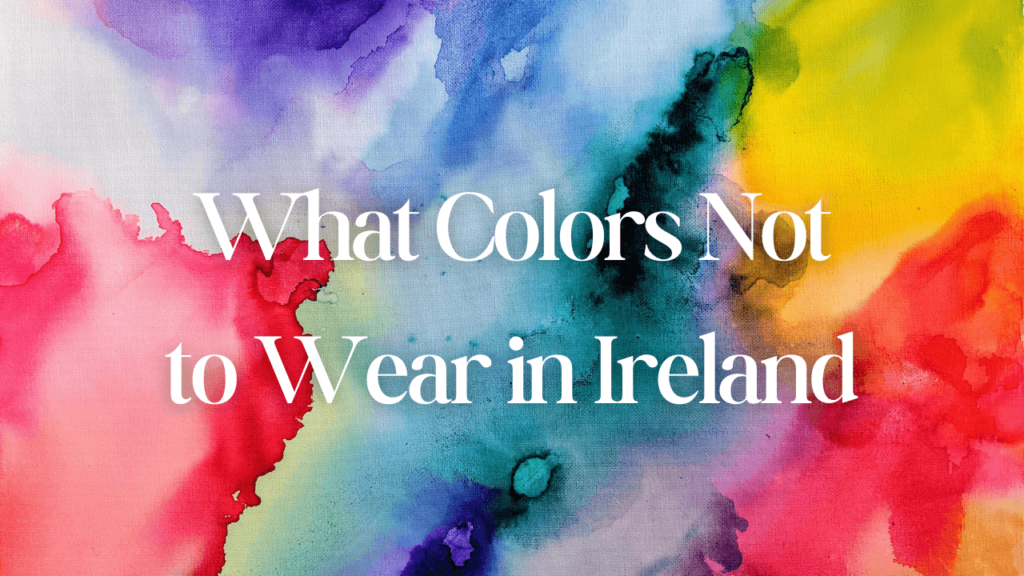When visiting Ireland, most travelers focus on packing for the country’s unpredictable weather. However, what many people don’t realize is that the colors they wear can also matter. Ireland has a rich cultural and historical background, and some colors carry political, social, or even superstitious meanings. While most Irish people today are welcoming and open-minded, understanding color associations can help you avoid any unintended offense.
In this guide, we’ll cover the colors you might want to avoid wearing in Ireland, explain their significance, and offer tips on what to wear instead.
Why Does Color Choice Matter in Ireland?
Certain colors in Ireland have historical and political connotations, especially in relation to the country’s past conflicts. Additionally, some colors are linked to superstitions or specific cultural beliefs. Here’s why color choice can be important:
- Political Sensitivity: Ireland has a long history of division between different groups, especially in Northern Ireland.
- Cultural Associations: Some colors are strongly tied to Irish identity, religion, or historical events.
- Superstitions: Like many countries, Ireland has superstitions related to colors.
While most Irish people won’t take offense at your clothing, knowing these associations can help you be more respectful and blend in better.
Colors to Avoid Wearing in Ireland
1. Avoid Wearing Too Much Orange
Why?
- Orange is closely linked to the Protestant community in Northern Ireland.
- It is associated with the Orange Order, a group that commemorates William of Orange’s victory in the Battle of the Boyne.
- Wearing orange, especially on certain dates like July 12th (Orange Day), may be seen as a political statement.
What to Wear Instead:
- If you like warm colors, opt for shades like rust, peach, or tan.
- If you wear orange, keep it subtle and avoid full outfits in this color.
2. Be Cautious with Green in Northern Ireland
Why?
- Green is a symbol of Irish nationalism and is strongly linked to the Catholic community.
- In Northern Ireland, wearing green could be seen as showing support for one political side.
- While green is generally fine in the Republic of Ireland, be mindful in Northern Ireland.
What to Wear Instead:
- Darker shades like forest green or muted olive are safer choices.
- If you want to show appreciation for Irish culture, wearing a small green accessory is a good option.
3. Avoid Wearing Black in Certain Situations
Why?
- In Ireland, black is associated with funerals and mourning.
- The color black is also linked to Irish political movements, such as the Irish Republican Army (IRA).
- All-black outfits can sometimes feel too formal or somber.
What to Wear Instead:
- Dark navy or charcoal gray can provide a sophisticated alternative.
- If you do wear black, mix it with other colors to soften the look.
4. Red Can Be Controversial in Some Areas
Why?
- Red has been historically associated with the British military, particularly in Northern Ireland.
- Some football (soccer) teams use red, which might unintentionally signal support for a specific side.
What to Wear Instead:
- Burgundy or maroon are more neutral variations of red.
- If wearing red, avoid bold all-red outfits.
5. Yellow Can Be Seen as a Sign of Bad Luck
Why?
- In Irish folklore, yellow has been associated with betrayal and bad luck.
- Some Irish superstitions view yellow as an unlucky color for clothing.
What to Wear Instead:
- Mustard or gold tones are a safer choice if you like warm colors.
- If you wear yellow, consider using it as an accent rather than the main color.
6. Bright Neon Colors Can Stand Out Too Much
Why?
- Irish fashion tends to be more understated and practical.
- Neon colors can make you stand out, especially in rural areas.
What to Wear Instead:
- Earth tones, blues, and grays blend in better with the local style.
- If you enjoy bright colors, choose muted versions rather than fluorescent shades.
A Quick Comparison Table
| Color | Reason to Avoid | Alternatives |
|---|---|---|
| Orange | Linked to Protestantism and the Orange Order | Rust, tan, peach |
| Bright Green | Strongly associated with Irish nationalism | Olive, forest green |
| Black | Associated with mourning and political groups | Dark navy, charcoal gray |
| Red | Linked to British military and football teams | Burgundy, maroon |
| Yellow | Considered unlucky in Irish folklore | Mustard, gold |
| Neon Colors | Too flashy and uncommon in Irish fashion | Earth tones, soft pastels |
What Colors Should You Wear in Ireland?
Now that you know which colors to be careful with, here are some great options for blending in while still looking stylish:
✔ Earth Tones: Brown, beige, olive, and gray are practical and stylish.
✔ Navy Blue: A versatile color that works well in both cities and rural areas.
✔ Soft Pastels: Light blues, soft pinks, and muted greens are safe and attractive.
✔ Layered Neutrals: Ireland’s weather is unpredictable, so layering with neutral colors is always a good idea.
Additional Tips for Dressing in Ireland
- Layer Up: The weather changes quickly, so bring layers like sweaters, jackets, and scarves.
- Comfortable Shoes: Irish cities have a lot of cobblestone streets—wear comfortable walking shoes.
- Avoid Overly Touristy Clothing: Items like “Kiss Me, I’m Irish” shirts might be fun but can make you stand out as a tourist.
- Dress for the Weather: A waterproof jacket is essential, as rain showers are frequent.
Frequently Asked Questions
Why Should I Avoid Wearing Bright Colors In Ireland?
Bright colors can make you stand out in Ireland. Locals typically prefer more muted, earthy tones. Bright colors can also attract attention in ways that might make you uncomfortable.
Are There Cultural Reasons For Color Choices In Ireland?
Yes, certain colors have cultural significance. For example, orange is associated with historical conflicts. Wearing culturally sensitive colors helps you show respect and blend in.
Is Black A Good Color To Wear In Ireland?
Yes, black is a versatile and practical choice. It blends well with Ireland’s often rainy, muddy conditions. Black is also widely accepted in both casual and formal settings.
What About Wearing Green In Ireland?
Green is generally a safe and popular choice. However, avoid overly bright or neon greens. Subtle, earthy greens are preferred.
Conclusion
Understanding what colors to avoid in Ireland ensures a smooth and respectful visit. Stick to neutral tones and avoid political or sports-related colors. Respect local customs and enjoy your trip without drawing unwanted attention. Dressing appropriately enhances your experience and helps you blend in seamlessly with the local culture.

Hi, I’m Tanvir, the founder and author of Explore Ireland Now. With a deep love for Ireland and its rich culture, history, and landscapes, I created this site to share everything that makes this beautiful country worth exploring. Whether you’re a local looking for hidden gems or a traveler planning your next adventure, I provide insightful guides, tips, and recommendations to help you experience Ireland to the fullest.
From stunning landscapes to vibrant cities and quaint villages, Ireland is full of wonders waiting to be discovered. Through my personal experiences and research, I aim to bring you the most up-to-date information and inspiration for your journey.
Thank you for visiting Explore Ireland Now—I hope my content helps you uncover all that this incredible country has to offer! If you have any questions or need travel advice, feel free to reach out.



